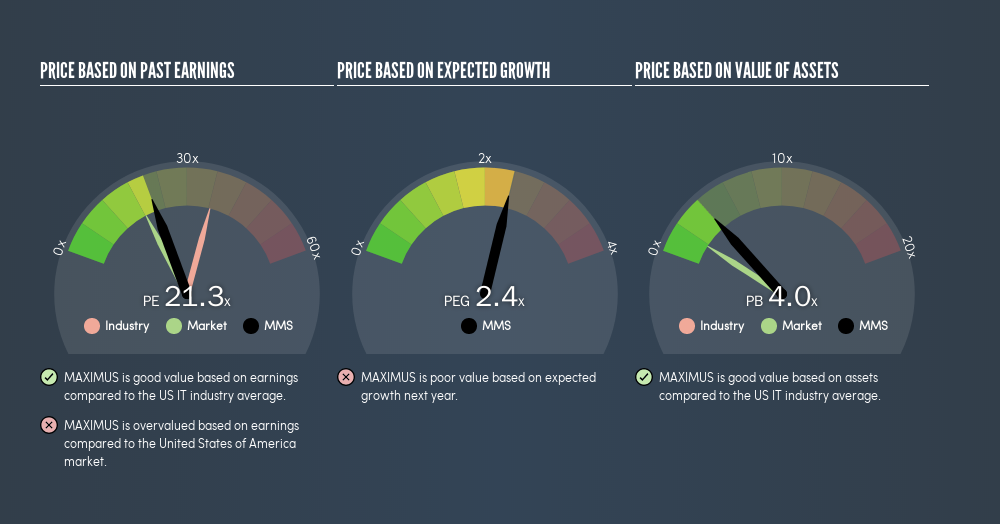- United States
- /
- Professional Services
- /
- NYSE:MMS
Do You Know What MAXIMUS, Inc.'s (NYSE:MMS) P/E Ratio Means?

Want to participate in a short research study? Help shape the future of investing tools and you could win a $250 gift card!
The goal of this article is to teach you how to use price to earnings ratios (P/E ratios). We'll look at MAXIMUS, Inc.'s (NYSE:MMS) P/E ratio and reflect on what it tells us about the company's share price. What is MAXIMUS's P/E ratio? Well, based on the last twelve months it is 21.29. That corresponds to an earnings yield of approximately 4.7%.
View our latest analysis for MAXIMUS
How Do I Calculate A Price To Earnings Ratio?
The formula for price to earnings is:
Price to Earnings Ratio = Price per Share ÷ Earnings per Share (EPS)
Or for MAXIMUS:
P/E of 21.29 = $73.51 ÷ $3.45 (Based on the year to March 2019.)
Is A High P/E Ratio Good?
A higher P/E ratio means that investors are paying a higher price for each $1 of company earnings. That is not a good or a bad thing per se, but a high P/E does imply buyers are optimistic about the future.
How Growth Rates Impact P/E Ratios
Earnings growth rates have a big influence on P/E ratios. When earnings grow, the 'E' increases, over time. And in that case, the P/E ratio itself will drop rather quickly. And as that P/E ratio drops, the company will look cheap, unless its share price increases.
MAXIMUS had pretty flat EPS growth in the last year. But over the longer term (5 years) earnings per share have increased by 11%.
Does MAXIMUS Have A Relatively High Or Low P/E For Its Industry?
The P/E ratio essentially measures market expectations of a company. The image below shows that MAXIMUS has a lower P/E than the average (36.4) P/E for companies in the it industry.

Its relatively low P/E ratio indicates that MAXIMUS shareholders think it will struggle to do as well as other companies in its industry classification.
A Limitation: P/E Ratios Ignore Debt and Cash In The Bank
The 'Price' in P/E reflects the market capitalization of the company. In other words, it does not consider any debt or cash that the company may have on the balance sheet. Hypothetically, a company could reduce its future P/E ratio by spending its cash (or taking on debt) to achieve higher earnings.
Such expenditure might be good or bad, in the long term, but the point here is that the balance sheet is not reflected by this ratio.
So What Does MAXIMUS's Balance Sheet Tell Us?
MAXIMUS's net debt is 0.7% of its market cap. It would probably trade on a higher P/E ratio if it had a lot of cash, but I doubt it is having a big impact.
The Verdict On MAXIMUS's P/E Ratio
MAXIMUS's P/E is 21.3 which is above average (18.2) in the US market. With debt at prudent levels and improving earnings, it's fair to say the market expects steady progress in the future.
When the market is wrong about a stock, it gives savvy investors an opportunity. As value investor Benjamin Graham famously said, 'In the short run, the market is a voting machine but in the long run, it is a weighing machine.' So this free visualization of the analyst consensus on future earnings could help you make the right decision about whether to buy, sell, or hold.
Of course you might be able to find a better stock than MAXIMUS. So you may wish to see this free collection of other companies that have grown earnings strongly.
We aim to bring you long-term focused research analysis driven by fundamental data. Note that our analysis may not factor in the latest price-sensitive company announcements or qualitative material.
If you spot an error that warrants correction, please contact the editor at editorial-team@simplywallst.com. This article by Simply Wall St is general in nature. It does not constitute a recommendation to buy or sell any stock, and does not take account of your objectives, or your financial situation. Simply Wall St has no position in the stocks mentioned. Thank you for reading.
About NYSE:MMS
Solid track record established dividend payer.
Similar Companies
Market Insights
Community Narratives





